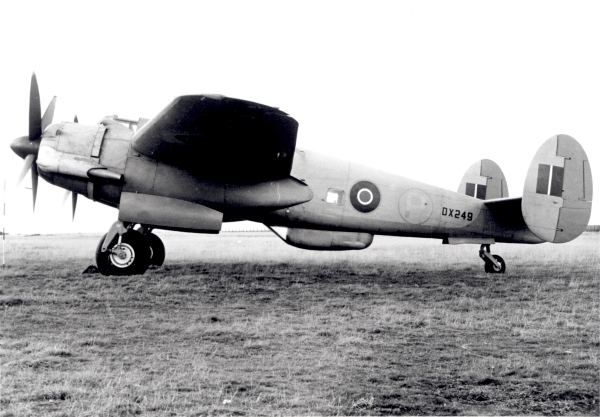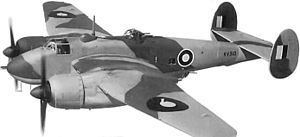Top speed 541 km/h Length 14 m | Wingspan 22 m First flight February 4, 1943 | |
 | ||
The Bristol Type 163 Buckingham was a British Second World War medium bomber for the Royal Air Force (RAF). Overtaken by events, it was built in small numbers, and was used primarily for transport and liaison duties.
Contents

Design and development

In early 1939 Bristol suggested a bomber variant of the Beaufighter with their Hercules engines. British policy at the time was an expectation for medium bombers to be provided from the US allowing British industry to concentrate on heavy bomber designs but a design was requested preferably based on an existing design which meant working with the Beaufighter or Beaufort. Bristol worked on their design first as the Bristol Type 161 then the Type 162 Beaumont.

Air Ministry specification B.7/40 called for a medium bomber to replace the Blenheim. The specification stipulated a speed of at least 300 mph at 5,000 ft, a normal load of 1,000 lb of bombs and a centre turret armed with at least two 0.5 inch (12.7 mm) machine guns. Only one manufacturer (Armstrong Whitworth) tendered a full design but it did not meet with approval. So when Bristol brought their Type 162 ("tentatively named Beaumont"), which was fortunately well matched to B.7/40, to the Air Staff, this led to a request to complete a mockup in 1940 and then a confirmed contract for three prototypes in February 1941. The Beaumont was based on the rear fuselage and tail of a Beaufighter, with a new centre and front fuselage. The armament was a mid-upper turret with four machine guns, four more machine guns firing forward and two firing to the rear.

Construction began in late 1940, with a new Air Ministry Specification B.2/41 to be written around it. Changes in the requirements, removing dive bombing and "direct army support" which incoming US bombers were expected to be capable of and increasing the performance to allow for the future, meant the Beaumont would no longer suffice. The changes in performance (requiring a bomb load of 4,000 lb, a speed of 360 mph and a range of 1,600 miles) meant a redesign by Bristol to use the Bristol Centaurus engine.
The Bristol redesign with a larger wing and the more powerful engines was the Type 163 Buckingham. It had gun installations in the nose, dorsal and ventral turrets. Generally conventional in appearance, one unusual feature was that the bomb-aimer/navigator was housed in a mid-fuselage ventral gondola, resembling those on the earlier German Heinkel He 111H and American Boeing B-17C and -D in appearance. This was part of an attempt to give all the crew positions unobstructed views and access to each other's positions. The bomb bay could hold a 4,000 lb, two 2,000 lb, four 1,000 lb or six 500-lb bombs. The rear of the gondola had a hydraulically powered turret with two 0.303 Browning machine guns. The Bristol-designed dorsal turret carried four Brownings. A further four fixed, forward-firing Brownings were controlled by the pilot. Following more changes, specification B.2/41 was replaced by B.P/41. An order for 400, at an initial rate of 25 per month, was made with deliveries expected in March 1943 but Bristol were still concerned that this not a reasonable scale and would prove expensive, and as such complained to MAP about poor planning. The first flight took place on 4 February 1943. During testing, the Buckingham exhibited poor stability which led to the enlargement of the twin fins, along with other modifications.
Operational history
By the time the design entered production, requirements had changed, with attacks against German industry being covered by the US by day and by RAF Bomber Command de Havilland Mosquitos by night. The Buckingham was not considered suitable for unescorted daytime use over Europe and in January 1944, it was decided that all Buckinghams would be sent overseas to replace Vickers Wellingtons.
Once the Buckingham's handling problems were revealed, it was realised that the type was of little use. As a result, it was cancelled in August 1944. To keep the Bristol workforce together, for later production of the Brigand and the Hawker Tempest, a batch of 119 were built. Uses for the aircraft were sought and a conversion to a communications aircraft was devised.
After the first 54 had been built as bombers, the remainder were converted for high-speed courier duties with RAF Transport Command. The gun installations were removed and four seats and windows fitted in the fuselage. The aircraft was named Buckingham C.1. Despite its 300 mph (480 km/h) speed and superior range to the Mosquito transports, with room for only four passengers, the Buckingham was rarely put to use. A total of 65 Buckingham bombers were unfinished on the production line and ended up being rebuilt as the Buckmaster, a trainer for the similar Brigand. Considered the "highest performance trainer in the RAF," the Buckmaster continued to serve as a trainer until its eventual retirement in the mid-1950s.
Variants
Operators
Specifications (Buckingham C.1)
Data from Flight
General characteristics
Performance
